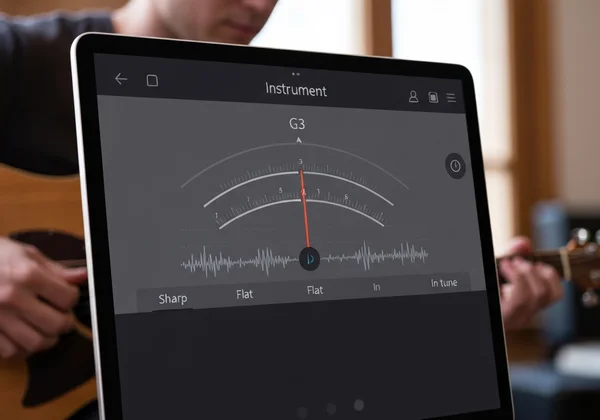Tuner Ninja: Your Ultimate Online Instrument Tuning Guide
Ever struggled with a sour note ruining your practice? Say goodbye to frustrating off-key sounds and hello to pitch-perfect harmony. This isn't just an instrument tuning guide; it's your blueprint to unlocking flawless sound with a true tuner ninja's precision, crafted for musicians who demand convenience and mastery. We'll explore everything from the science of sound to practical steps, and answer the crucial question: How to tune a guitar for free online? Get ready to unlock your instrument’s true voice with a free, precise, and engaging online companion.

The Science of Sound: Understanding Music Tuning Principles
Before you tune your first string, understanding the "why" behind the process builds a solid foundation. Tuning isn't just about matching sounds; it's about aligning with the fundamental principles of music and physics. Mastering these concepts is the first step in a ninja's training.
What are Pitch, Frequency, and Cents in Tuning?
At its core, a musical note is a sound wave vibrating at a specific speed. This speed is its frequency, measured in Hertz (Hz). The higher the frequency, the higher the pitch we perceive. For example, the standard A note vibrates at 440 Hz. To achieve perfect tuning, we need an even finer measurement: cents. A cent is 1/100th of a semitone (the distance between two adjacent notes on a piano). This tiny unit allows for incredible precision, and a high-quality tuner will measure your pitch down to the cent.
The A440 Standard: The Universal Language of Music
In 1939, an international agreement established A4 = 440 Hz as the standard tuning pitch. This "A440 standard" ensures that a C note played on a guitar in London sounds the same as a C note played on a piano in Tokyo. It's the universal language that allows musicians worldwide to play together in harmony. Most modern tuners, including the one you'll find at this free online tuner, are calibrated to this universal standard for global compatibility.
Why Accurate Tuning is Your Musical Foundation
Accurate tuning is non-negotiable for any serious musician. It's the foundation upon which all your playing is built. An in-tune instrument ensures that the chords you learn sound correct, your ear develops a proper sense of pitch, and you sound harmonious when playing with other musicians. Neglecting it is like building a house on shaky ground—sooner or later, everything will fall apart. Consistent, precise tuning is a discipline that separates the amateur from the master.
Choosing Your Tuning Method: Ear vs. Digital Tuners
Every musician faces a choice: rely on the ancient art of tuning by ear or embrace the precision of modern technology. While both have their merits, one method offers undeniable speed, accuracy, and convenience for players of all levels.
The Art of Tuning By Ear: Developing Your Musical Instinct
Tuning by ear involves using a reference note (from a piano or tuning fork) and matching your instrument's strings to it by listening for dissonance. This is an excellent skill for training your musical ear and understanding intervals. However, it requires significant practice, a quiet environment, and a well-developed sense of relative pitch, making it challenging for beginners.
The Precision of a Digital Tuner: How They Work
A digital tuner is a device or software that analyzes the frequency of a sound wave and displays its corresponding musical note. Most online versions, including this precise instrument tuner, function as a microphone tuner. They use your device's built-in microphone to "listen" to the note you play, instantly calculate its frequency, and show you whether it's sharp (too high), flat (too low), or perfectly in tune. This technology removes the guesswork, providing objective, data-driven feedback.

Online Tuner vs. Hardware Tuner: Which is Best for You?
Hardware tuners (clip-on or pedal) have been a musician's staple for years. They are reliable but come at a cost, can be misplaced, and require batteries. A modern web based tuner offers a powerful alternative. It costs nothing, requires no installation, and is always available on any device with a web browser. With advanced algorithms, a high-quality online tool can match or even exceed the accuracy of many hardware devices. For convenience and accessibility, a reliable tuner ninja like an online instrument tuner is an unbeatable choice for students, hobbyists, and even professionals.
Master Your Instrument: A Step-by-Step Online Tuning Guide
You understand the principles and have chosen your weapon of choice. Now it's time for the practical mission: achieving perfect pitch. Using an online tuner is simple, fast, and incredibly effective. Let's walk through the process.
Getting Started: Your Free Tuner Ninja Chromatic Tuner Online
A chromatic tuner can detect all 12 notes in the Western musical scale, making it versatile enough for virtually any instrument. This is a powerful, free online chromatic tuner designed for ease of use.
- Navigate to our homepage.
- Select your instrument (e.g., Guitar, Bass, Ukulele) for standard tuning reference, or leave it on Chromatic for universal use.
- Click the "Start Tuning" button.
Using Your Device's Microphone for Accurate Pitch Detection
Once you start the tuner, your browser will ask for permission to access your microphone. This is a crucial step. Granting access allows the tool to listen to your instrument. Don't worry—here, this audio data is processed directly in your browser and is never stored or uploaded, ensuring your privacy. Position your device's microphone near your instrument for the best results.
Tuning Specific Instruments: Guitar, Bass, Ukulele, & More
Whether you need an online guitar tuner or a bass tuner online, the process is the same. Pluck a single string and watch the tuner's display.
- If the needle is to the left, the note is flat (too low). Tighten the string's tuning peg slowly.
- If the needle is to the right, the note is sharp (too high). Loosen the tuning peg slightly.
- Aim for the center. When the needle is in the middle and the display glows green, your note is perfectly in tune.
Repeat this process for each string. Soon, you'll be able to tune your instrument with the speed and accuracy of a ninja. This is the goal of any modern tuner ninja tool.

Advanced Tuning Tips & Maintaining Your Perfect Pitch
Once you've mastered the basics, you can move on to more advanced techniques. A true tuner ninja knows that maintaining your instrument's tuning is a continuous discipline.
Beyond Standard: Exploring Alternate Guitar Tunings
Many guitarists explore alternate tunings like Drop D, Open G, or DADGAD to create unique sounds and moods. A chromatic tuner is essential for this. Simply pluck the string you want to retune and adjust the peg until the display shows your desired target note. It's a fantastic way to expand your creative horizons.
Stretching New Strings for Optimal Tuning Stability
New strings are prone to stretching, causing them to go flat quickly. After installing a new set, tune each string up to pitch, then gently pull it away from the fretboard to stretch it. You'll notice the pitch has dropped. Re-tune and repeat this process a few times until the pitch remains stable after stretching.

The Ninja's Discipline: Regular Tuning Checks for Consistent Sound
Your instrument is affected by changes in temperature and humidity, not to mention the stress of playing. Make it a habit to check your tuning every time you pick it up. This simple, two-minute discipline ensures you always sound your best and reinforces the muscle memory of perfect pitch. A quick check with a reliable online tuner is all it takes.
Unlock Your Musical Potential: Start Tuning Today!
Tuning is not a chore; it's the first step to making beautiful music. It’s the discipline that connects you to your instrument and unlocks its full potential. By understanding the principles and using a precise, accessible tool, you can ensure every note you play is clear, resonant, and true.
Ready to command perfect pitch? Your journey to flawless sound starts now. Experience the ultimate tuner ninja advantage: Experience our free online tuner for a precise, engaging, and absolutely free online tuning experience. Let every note resonate perfectly!
Frequently Asked Questions About Online Instrument Tuning
Is an online tuner as accurate as a hardware tuner?
Absolutely. A high-quality online tuner uses advanced pitch-detection algorithms to achieve incredible accuracy—in our case, up to ±0.1 cents. This level of precision is comparable to many professional-grade hardware tuners, making it a reliable tool for musicians at all levels.
What makes this the best free instrument tuner online?
This tuner stands out by combining extreme precision with a fun, immersive user experience. It's the ultimate tuner ninja tool for musicians, being completely free, requiring no downloads, and working on any device. The unique theme and gamified elements make a routine task enjoyable, while its core technology delivers the accuracy musicians demand.
How does a microphone tuner accurately detect my instrument's pitch?
A microphone tuner uses a process called Fast Fourier Transform (FFT) to analyze the sound waves captured by your device's microphone. It breaks down the complex sound into its fundamental frequencies, identifies the most dominant one, and converts that frequency (in Hz) into its corresponding musical note and pitch deviation (in cents).
Can I use this free online tuner to tune my violin or other orchestral instruments?
Yes! This online chromatic tuner features a fully chromatic mode, which means it can detect any of the 12 notes in the Western scale. This makes it a perfect online chromatic tuner for a wide variety of instruments, including violin, viola, cello, banjo, mandolin, and many more.
How do I effectively use a chromatic tuner online for alternate tunings?
Using a chromatic tuner for alternate tunings is straightforward. First, know the specific notes for your desired tuning (e.g., Drop D is D-A-D-G-B-E). Then, pluck each string one by one and adjust its tuning peg until the tuner's display shows you've hit the target note for that string. It's the most flexible way to explore new sonic landscapes.